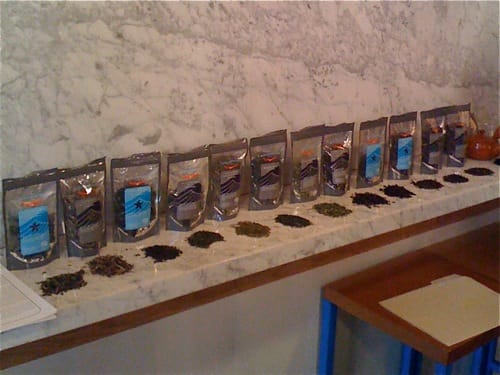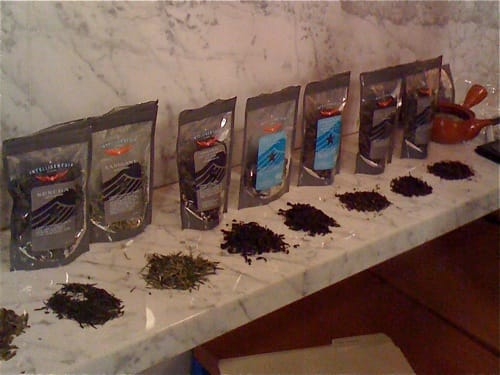It’s not my style to write three times about one place in six months, but there always seems to be something interesting happening at Intelligentsia, which has become something of a community hub for Silver Lakers. As I was settling in at the coffee bar, I discovered that company Tea Buyer Doug Palas was in town from Chicago to educate customers about Intelligentsia’s other, less publicized specialty.
Palas has worked for Intelligentsia for eight years, since there was only one store. He went from packaging coffee to purchasing dried goods and tea. Intelligentsia founder Doug Zell previously owned a tea company, so he was always passionate about the leaf. After awhile, Zell wanted to match Intelligentsia’s high standards for coffee, so he needed to hire someone full time. Palas said, “I would always ask Doug questions about tea. It got to the point where he couldn’t answer the questions I was asking.” At that point, he was hired as the company’s dedicated tea buyer.

Doug Palas lined up a dozen different packages of Intelligentsia tea on a marble counter, a spectrum running from White Peony on the left to black Satrupa Assam Summer Reserve on the right. He also poured piles of each leaf, so he could see what they looked like before steeping. He offered to steep all twelve if we wanted, on the house.
Ten of the teas are currently available at the Silver Lake location, but his first selection was not: Organic Osthmanthus Oolong. There were only 22 pounds of this particular tea available in the U.S., and Doug bought all 22. The amber liquid was incredibly fragrant and flavorful.
As Doug steeped his teas, he fielded a variety of tea questions, yielding a stream of information that may have been basic to him, but was illuminating to his small audience. For example, we learned that tea plants are evergreen. They never lose their leaves. The first flush is the first harvest, normally from February to May, better for green. The second flush is June to July, better for black tea. Sometimes there’s a third flush.
Indians are the biggest tea producers, but they consume more than they produce. China is the birthplace of tea and is the second largest producer. Japan is also a tea power, though all their leaves are machine picked, which damages tea leaves.
Any tea leaf can be white, green or black, depending on the amount of oxidation the dry tea leaves receive. Heat halts oxidation, keeping it green. White tea leaves are baby tea leaves grown in China’s Fujian province. Black tea leaves are up to 100% oxidized.
Plants store nutrients up top, so top-side pekoe leaves are the most desirable on tea plants, followed by orange pekoe, then low-down suchong.

Back to the tasting. Doug’s second selection was Buddhist Tea, a green tea. His handout won’t be available online until the Intelligentsia website is overhauled, but it said that Buddhist tea was harvested in April 2007 from a sacred mountain on a small island in Zheijiang Province, China, that’s home to Buddhist temples. The leaves are pan-fired in a wok over a charcoal fire. Characteristics include syrupy body, delicate and fruity flavor, smooth, fresh finish and grassy aroma.
Third up was Karigane, a green tea with yellow color that isn’t on the shelves yet at Intelligentsia. It was harvested in Uji, Kyoto, Japan, in May 2007. According to Doug’s tasting notes, characteristics are rounded, subtle body, delicate green flavor, clean, peppery finish and an aroma of brown butter or sesame oil. He said, “Fresh tea has a distinct wafting aroma.” With one sniff, there was no doubt the Karigane was fresh.
Doug continued to drop more tea knowledge, focusing on caffeine. Cooler water extracts less caffeine. Caffeine is also the first thing to leave the tea leaves. Subsequent steepings have less caffeine.
Green tea can stay fresh for up to a year. Essential oils dissipate over time, and a tea-hauling boat can take up to three months to arrive in the U.S. Air freight helps, but you can only sell it for a short time. This informed Doug’s decision to have a seasonal tea menu. Black teas are good for two years, if stored properly. English breakfast gets better over time, but it’s an exception.

Our fourth sample was Satrupa Assam Summer Reserve, which featured a light brown hue. Doug said that Assam is a state in Northeast India, very dangerous due to the presence of separatists groups that make it hard to get tea out of the country.
Doug said, “When you steep black tea, use 250 degree water, boiling.” The second infusion on black teas isn’t as good. High-end Japanese teas steep at 140-150 degrees. Green should be around 175.
During the course of the tasting, Doug said matter-of-fact, “All my teas are good.” Immodest? Probably. Correct? More than likely. Thanks to Doug, after being exposed to four different Intelligentsia teas, it’s no longer automatic that I’ll order coffee the next time I sit at the coffee bar.




Leave a Comment